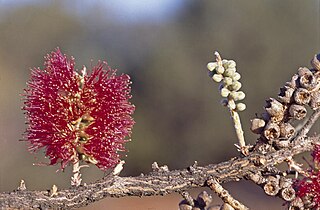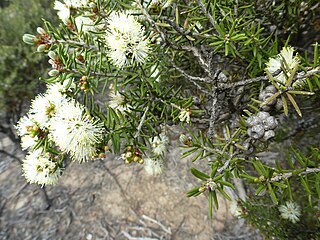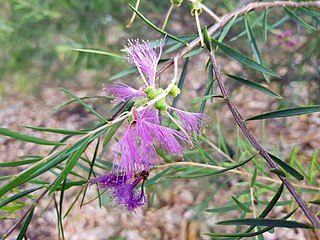
Melaleuca huegelii, commonly known as chenille honey-myrtle, is a plant in the myrtle family, Myrtaceae and is endemic to the south-west coastal areas of Western Australia. It has small, almost scale-like leaves and flower spikes sometimes more than 100 millimetres (4 in) long on the ends many of its branches.

Melaleuca viminalis, commonly known as weeping bottlebrush or creek bottlebrush, is a plant in the myrtle family Myrtaceae, and is endemic to New South Wales, Queensland and Western Australia. It is a multi-trunked, large shrub or tree with hard bark, often pendulous foliage and large numbers of bright red bottlebrush flowers in spring and summer. It is possibly the most commonly cultivated melaleuca in gardens and its cultivars are often grown in many countries.

Melaleuca fulgens, commonly known as the scarlet honey myrtle, is a plant in the myrtle family Myrtaceae, and is endemic to Western Australia, South Australia and the Northern Territory. It is notable for its showy orange, red or purple flowers, unusual foliage and fruit, and is a popular garden plant. It is a member of Melaleuca, a large and diverse genus whose members range from large trees such as M. quinquenervia, to small shrubs.
Melaleuca penicula is a plant in the myrtle family, Myrtaceae and is endemic to the south of Western Australia. It is a rare species only known from the Fitzgerald River National Park and resembles Melaleuca eximia with its spikes of red flowers but its leaves and stamen bundles are different.

Melaleuca dempta is a plant in the myrtle family, Myrtaceae and is endemic to the south-west of Western Australia. It is an erect shrub resembling Melaleuca calycina with its heads of white flowers and egg-shaped to heart-shaped leaves. It was formerly considered a subspecies of Melaleuca calycina subsp. dempta but it lacks the star-like fruits of that species and its leaves have a blunt rather than a pointed tip.
Melaleuca eximia is a plant in the myrtle family, Myrtaceae and is endemic to the south of Western Australia. It is distinguished by its leaf arrangement, its large, showy red inflorescences and the large, furry bracts under the flowers.

Melaleuca longistaminea is a plant in the myrtle family Myrtaceae, and is endemic to the south-west of Western Australia. It is a shrub with small, prickly, heart-shaped leaves and heads of yellow to green flowers on the sides of the stems in winter and spring. It is similar to Melaleuca spectabilis which was formerly included in this species but has smaller flowerheads and narrower leaves.

Melaleuca adenostyla is a plant in the myrtle family, Myrtaceae and is endemic to the south-west of Western Australia. It is a large, broom-like shrub to about 5 metres (16 ft) high with narrow leaves and cream-coloured flowers and which often grows in saline places.

Melaleuca apostiba is a shrub in the myrtle family, Myrtaceae and is endemic to the south-west of Western Australia. It was first described in 1990 by Kirsten Cowley and remains a poorly known species. It resembles Melaleuca lateritia except for its hairy leaves and flower structures as well as its leaf shape and size.

Melaleuca coccinea, commonly known as the goldfields bottlebrush is a shrub in the myrtle family Myrtaceae and is endemic the south of Western Australia. It is distinguished by its unusual foliage and bottlebrush spikes of red flowers.

Melaleuca lecanantha is a plant in the myrtle family, Myrtaceae and is endemic to a small area of south-west Western Australia. It is a shrub with small, rather fleshy leaves and pink to lilac-coloured flowers in early spring. The plant was first described in 1867 but the name given to it was considered illegitimate and it was not until 1998 that it was first formally described.

Melaleuca incana, commonly known as grey honey-myrtle, is a plant in the myrtle family, Myrtaceae and is endemic to the south-west of Western Australia and is naturalised in the south of Victoria in Australia. It is commonly grown as a garden plant and produces large numbers of white or creamy yellow flowers, sometimes highly scented, in spring.

Melaleuca lateriflora, commonly known as gorada, is a plant in the myrtle family, Myrtaceae and is endemic to the south-west of Western Australia. It is usually an erect shrub with oval leaves and small clusters of white flowers mainly along the older branches.

Melaleuca macronychia is a shrub in the myrtle family Myrtaceae, endemic to the south-west of Western Australia. Its large, red flower spikes and long flowering period contribute to its popularity as a garden plant. There are two subspecies, distinguished mainly by the shape of the leaves.

Melaleuca pauperiflora, commonly known as boree, is a plant in the myrtle family, Myrtaceae, and is native to the southern parts of South Australia and Western Australia. It is distinguished by its short, thick leaves and small but profuse heads of white or cream flowers. There are three subspecies.

Melaleuca spectabilis is a plant in the myrtle family, Myrtaceae, and is endemic to the south-west of Western Australia. It was formerly known as a subspecies of Melaleuca longistaminea. It is a low, prickly shrub with yellow or lime-green flowers in spring and early summer.

Melaleuca teuthidoides is a plant in the myrtle family, Myrtaceae and is endemic to the south of Western Australia. It is a shrub with rough bark and heads of white flowers on the ends of its branches in spring and early summer.
Melaleuca calcicola is a plant in the myrtle family, Myrtaceae and is endemic to the south of Western Australia. It was formerly known as a subspecies of Melaleuca apodocephala but was reassessed in 2010 and raised to species status. Its branches are corky, the leaves pointed although not prickly and the flowers are creamy white, tipped with yellow.

Melaleuca fulgens subsp. steedmanii, commonly known as the scarlet honey myrtle, is a plant in the myrtle family, Myrtaceae and is endemic to the south-west of Western Australia. In 1990, the species Melaleuca fulgens was separated into 3 subspecies. Of the two subspecies occurring in the south-west, this one has the narrower distribution, occurring mainly near Geraldton. As with the other subspecies, this one is notable for its showy flowers which are usually red but its foliage and fruits are also attractive features.
Calytrix breviseta is a species of flowering plant in the myrtle family Myrtaceae and is endemic to the south-west of Western Australia. It is a more or less glabrous shrub with egg-shaped, elliptic, lanceolate, oblong or linear leaves and clusters of purple flowers with about 25 to 65 white stamens in several rows, becoming reddish-purple as they age.



















